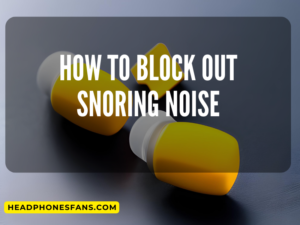The constant hum of city life, the drone of appliances, or the chatter of a busy workplace can often be a source of distraction or even stress. It's a common issue, and one that many seek solutions for. Noise Cancelling headphones are a popular choice, but they often fall short when it comes to blocking out human speech. In this article, we'll delve into the science behind this limitation, explore ways to enhance their voice-blocking performance, and provide practical tips for improving noise isolation.
We'll also consider a few product recommendations for those looking to combine the best of active and passive noise cancellation, and look into noise masking as an additional strategy. So, if you're trying to create a quieter environment or just craving a bit of peace and tranquility, read on.
The Science of Noise Cancellation
Noise cancelling headphones are fascinating pieces of technology. They work by producing sound waves that effectively 'cancel out' unwanted ambient noise. However, they are most effective within a certain frequency range, typically below 500 Hz and up to around 1000 Hz.
The problem with this? The critical frequencies for speech intelligibility – the range that allows us to understand what we're hearing – tend to lie within the 500 Hz to 4000 Hz range. As a result, most active noise cancelling (ANC) technology struggles to completely eliminate voices, especially those frequencies above 1000 Hz. Comparing two major brands such as JBL and Bose, can provide insight into their respective noise cancellation capabilities.
The Role of Passive Noise Isolation
Passive noise isolation, as offered by earmuffs or in-ear monitors, can provide a layer of sound blocking that complements the active noise cancelling of your headphones. Some noise cancelling headphones, like those compared here, are designed to offer superior passive noise isolation. This can help to fill the 'gaps' left by the limited frequency range of active noise cancellation, offering a more complete solution to the problem of unwanted noise.
Enhancing Voice-Blocking Performance
Noise masking is an innovative solution to the issue of residual noise, particularly human speech. By introducing a 'masking' noise, such as white noise or the sound of a babbling brook, the offending noise can be drowned out. The human brain is then able to filter out the steady, consistent sound of the masking noise, leaving you in relative peace.
Consider adjusting your Samsung soundbar to introduce a constant white noise for a peaceful environment.
Customizing White Noise for Speech Blocking
In a step beyond basic noise masking, the use of a flexible white noise generator can provide a more tailored solution. By adjusting the white noise output to target specific frequency bands, such as those associated with human speech, you can effectively 'shape' the noise to your specific needs.
A soundbar comparison would be an interesting place to look for white noise generator features.
Practical Tips for Improving Noise Blocking
For those who require even more noise isolation, consider combining your noise cancelling headphones with foam earplugs. This can offer a level of noise reduction that neither solution could achieve on their own. Comfort is a critical factor when considering this option, particularly for those who plan on wearing their headphones for extended periods.
When it comes to comfort, our [headphone comparison](/jbl-partybox-310-vs-300
/) has great options to consider.
Conclusion
Your personal experiences and preferences play a significant role in determining the best noise reduction strategy for you. Whether you favor active noise cancelling technology, passive noise isolation, noise masking, or a combination of these methods, you'll find a solution that works for you. Don't forget to consider other factors such as comfort and long-term wearability in your decision.
We hope this guide has been helpful in understanding the limitations of noise cancelling headphones when it comes to blocking out voices, and the various techniques you can employ to overcome these.
For more in-depth reviews and comparisons of sound systems and headphones, you may want to check out this comparison of Klipsch and Bose soundbars, or our analysis on Treblab and JBL speakers. You can also find interesting pieces on how to match speakers and amps, offering valuable insights to optimize your listening experience.

Hey there mobile audio lovers! My name is Darlene R, founder and chief editor at headphonesfans.com. Ask any mobile audio fanatic, installer, or company rep what makes a good car speaker, sub or amp, or, better yet, why he or she prefers a certain brand over another, and be prepared to endure a litany of opinions, viewpoints, and passion-fueled perspectives. To be honest, mobile audio shopping can be a daunting task without a guide, so I’ve assembled what I feel are the best products to consider to make things easier for you. Welcome headphonesfans.com!




